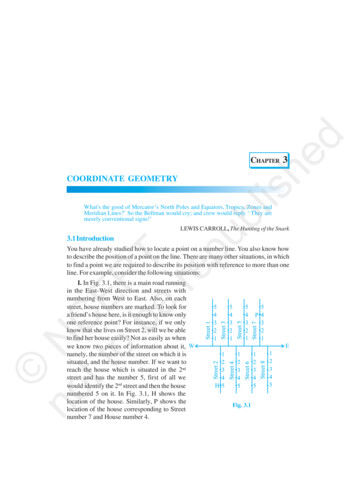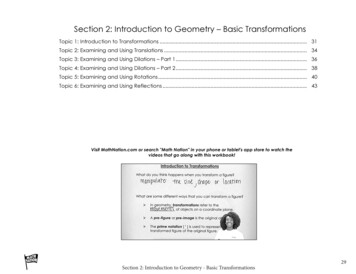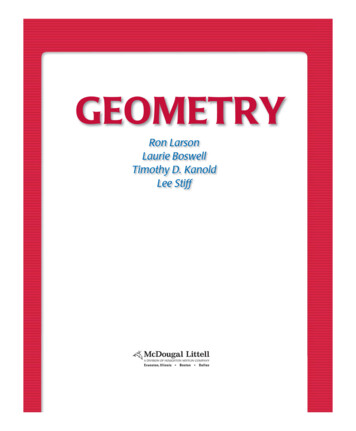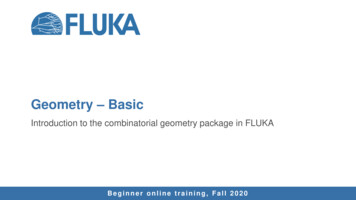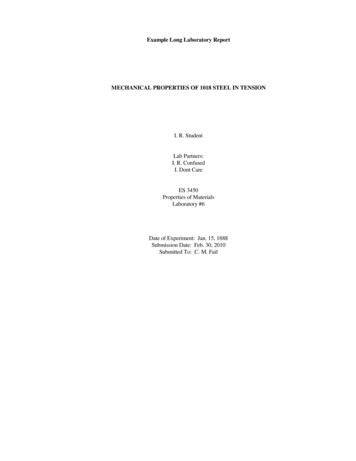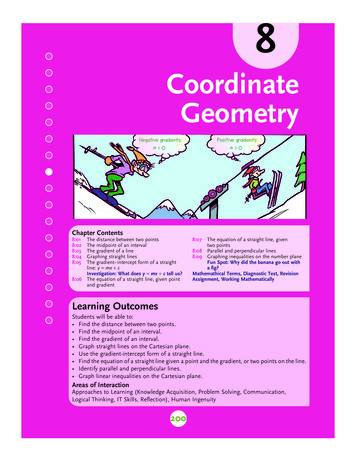
Transcription
8CoordinateGeometryNegative gradients:m 0Positive gradients:m 0Chapter Contents8:018:028:038:048:05The distance between two pointsThe midpoint of an intervalThe gradient of a lineGraphing straight linesThe gradient–intercept form of a straightline: y mx cInvestigation: What does y mx c tell us?8:06 The equation of a straight line, given pointand gradient8:07The equation of a straight line, giventwo points8:08 Parallel and perpendicular lines8:09 Graphing inequalities on the number planeFun Spot: Why did the banana go out witha fig?Mathemathical Terms, Diagnostic Test, RevisionAssignment, Working MathematicallyLearning OutcomesStudents will be able to: Find the distance between two points. Find the midpoint of an interval. Find the gradient of an interval. Graph straight lines on the Cartesian plane. Use the gradient-intercept form of a straight line. Find the equation of a straight line given a point and the gradient, or two points on the line. Identify parallel and perpendicular lines. Graph linear inequalities on the Cartesian plane.Areas of InteractionApproaches to Learning (Knowledge Acquisition, Problem Solving, Communication,Logical Thinking, IT Skills, Reflection), Human Ingenuity200
The French mathematician René Descartes first introduced the number plane. He realised thatusing two sets of lines to form a square grid allowed the position of a point in the plane to berecorded using a pair of numbers or coordinates.Coordinate geometry is a powerful mathematical technique that allows algebraic methods tobe used in the solution of geometrical problems.In this chapter, we will look at the basic ideas of: the distance between two points on the number plane the midpoint of an interval gradient (or slope) the relationship between a straight line and its equation.We shall then see how these can be used to solve problems.8:01 The Distance Between Two PointsThe number plane is the basis of coordinate geometry, an important branch of mathematics.In this chapter, we will look at some of the basic ideas of coordinate geometry and how theycan be used to solve problems.prep quA a 2 b2 c 2B b2 a 2 c 2iz1 Which of the following is the correct statement ofPythagoras’ theorem for the triangle shown?c8:01For questions 2 to 4, use Pythagoras’ theorem to find the value of d.23412 cmd cm4 cm3 cm5 cmbC c 2 a 2 b2a2mdmd cm4mCHAPTER 8 COORDINATE GEOMETRY201
5AB–1 0 1 2 3 4 5 6 7 8 xDistance AB . . . units.86y2 B10–1 A–2–37 Distance AB . . . units.Distance AB . . . units.y43A21 1 0 19 Find the distance AB.y11 2 3 4 5x10 Find the distance AB.y4–1 0 1 2 3 4 5 x–1A–2–3–4BBy43 AA 3B4x2Distance AB . . . units.B3–1xPythagoras’ theorem can be used to find the distance between two points on the number plane.worked examples1 Find the distance between the points (1, 2) and (4, 6).2 If A is ( 2, 2) and B is (4, 5) find the length of AB.Solutionsy127A(4, 6)6544332CB(1,2)11 2 3 4 5 6 7x–1 0–1c2 a 2 b2AB2 AC2 BC2 42 32 16 9 25 AB 25 the length of AB is 5 units.y7654B(–2, 2) 321A(4, 5)45 is asurd. Wesimplify surdsif they areperfectsquares.36C1 2 3 4 5x–3 –2 –1 0–1c2 a 2 b2AB2 AC2 BC2 32 62 9 36 45 AB 45 the length of AB is45 unit.By drawing a right-angled triangle we can use Pythagoras’ theorem to find thedistance between any two points on the number plane.yyyBBBBCAAx202INTERNATIONAL MATHEMATICS 4ACxCACx
Distance formulaA formula for finding the distance between two points,A(x1, y1) and B(x2, y2), can be found using Pythagoras’theorem. We wish to find the length of interval AB.NowRS y2 y1y1 S(ACML is a rectangle)O(BCSR is a rectangle)0AB2 AC2 BC2 (Pythagoras’ theorem) (x2 x1)2 (y2 y1)2 AB CA(x1, y1)(since RS RO SO) BC y2 y1NowB(x2, y2)y2 y1LM x2 x1 (since LM MO LO) AC x2 x1andyy2 RLx1x2 x1Mx2x( x2 – x1 )2 ( y2 – y1 )2The distance AB between A(x1, y1) and B(x2, y2) is given by:d ( x2 – x1 ) 2 ( y2 – y1 ) 2worked examples1 Find the distance between thepoints (3, 8) and (5, 4).2 Find the distance between thepoints ( 2, 0) and (8, 5)Solutions1 Distance ( x2 – x1 )2 ( y2 – y1 )2(x1, y1) (3, 8) and (x2, y2) (5, 4) d ( 5 – 3 )2 ( 4 – 8 )22 Distance ( x2 – x1 )2 ( y2 – y1 )2(x1, y1) ( 2, 0) and (x2, y2) (8, 5) d ( 8 – –2 )2 ( – 5 – 0 )2 ( 2 )2 ( –4 )2 ( 10 ) 2 ( – 5 ) 2 4 16 100 25 20 125 Distance 4·47 (using a calculatorto answer to 2 decimal places). Distance 11·18 (using a calculatorto answer to 2 decimal places). You should check that the formula will still give the same answer if the coordinatesare named in the reverse way. Hence, in example 1, if we call (x1, y1) (5, 4) and(x2, y2) (3, 8), we would produce the same answer.CHAPTER 8 COORDINATE GEOMETRY203
Exercise 8:011Foundation Worksheet 8:01Use Pythagoras’ theorem to find the length of each of thefollowing. (Leave your answer as a surd, where necessary.)aby109876543210cC(7, 1)y109876543211 2 3 4 5 6 7 8x0y4321dB(7, 9)86A(1, 1)B(4, 3)5–1 0 1 2 3 4 5 x–13–2C–3 A(1, –2)21272 Find the distance AB in each of the following.a yb yA5BAA(3, 6)2 42x6Bx3C(3, 3)4B(7, 3)1 2 3 4 5 6 7 8 xy5B( 3, 3) 43221C5 4 3 2 1 0 1 23 Find the length of AB in each of the following.a ybyB(5, 5)A( 2, 2)24A22 3 x 2(1, 2) 2x2 4B(3, 2)ey321A( 6, 2)A(2, 1)1 2 3x 6 5 4 3 2 1 0 15 2 3C12 41 2 3 4 5 6xB(6, 3)Find the lengths BC and AC and use these to find the lengths of AB. (Leave your answers insurd form.)yyyabcB(4, 4)B(5, 4)B( 7, 4)43214321dey54321 3 2 10 1 2B( 3, 2)A(4, 4)1 2 3 4xINTERNATIONAL MATHEMATICS 4CCA(1, 1) 1 0 1 2 3 4 5 x 1A(0, 0)C 1 0 1 2 3 4 5 x 1204Distance between points1 Use Pythagoras’ theorem to find the lengthof the hypotenuse in each of the following.abyx5 3C 3 2 1 0 1 2 3C 7 6 5 4 3 2 1 0 1fy4B( 2, 3)3211 2 3 4xA(2, 3)432A( 1, 2) 11xy2 4 3 2 10 1 2 3 4B( 4, 4) 51 2 3xA(2, 1)C
3Use Pythagoras’ theorem to find the length of interval AB in each of the following.(Leave answers in surd form.)yyyabcA(3, 6)654321 1 0 1d54321B(1, 2) 1 0 1 21 2 3 4 5xy5A( 2, 3) 4321 2 1 0 1 2eB(3, 1)1 2 3 4xA(4, 5)543B( 2, 1)21 2 1 0 1 21 2 3 4 5xB(1, 2)y5A(1, 3)4321 3 2 1 0 1 2B( 3, 2)1 2 xfy3210 1 2 3A(5, 3)1 2 3 4 5xA(8, 1)1 2 3 4 5 6 7 8xB(2, 1)4Use the formula d ( x 2 – x 1 ) 2 ( y 2 – y 1 ) 2 to find the distance between the points:a (4, 2) and (7, 6)b (0, 1) and (8, 7)c ( 6, 4) and ( 2, 1)d ( 2, 4) and (4, 4)e ( 6, 2) and (6, 7)f (4, 9) and ( 1, 3)g (3, 0) and (5, 4)h (8, 2) and (7, 0)i (6, 1) and ( 2, 4)j ( 3, 2) and ( 7, 3)k (6, 2) and (1, 1)l (4, 4) and (3, 3)5abcd6a The vertices of a triangle are A(0, 0), B(3, 4) and C( 4, 5).Find the length of each side.b ABCD is a parallelogram where A is the point (2, 3), B is (5, 5),C is (4, 3) and D is (1, 1). Show that the opposite sides of theparallelogram are equal.c Find the length of the two diagonals of the parallelogram in part b.d EFGH is a quadrilateral, where E is the point (0, 1), F is (3, 2), G is (2, 1) andH is ( 1, 2). Prove that EFGH is a rhombus. (The sides of a rhombus are equal.)e (3, 2) is the centre of a circle. (6, 6) is a point on the circumference. What is the radiusof the circle?f Prove that the triangle ABC is isosceles if A is ( 2, 1), B is (4, 1) and C is (2, 5).(Isosceles triangles have two sides equal.)g A is the point ( 13, 7) and B is (11, 3). M is halfway between A and B. How far isM from B?Find the distance from the point (4, 2) to the origin.Which of the points ( 1, 2) or (3, 5) is closer to the point (3, 0)?Find the distance from the point ( 2, 4) to the point (3, 5).Which of the points (7, 2) or ( 4, 4) is further from (0, 0)?Making a sketchwill help.CHAPTER 8 COORDINATE GEOMETRY205
8:02 The Midpoint of an Intervalprquizep8:02135674 10--------------2What is the average of 4 and 10?What number is halfway1 2 3 4between 4 and 10?What number is halfway–4 –3 –2 –1between 2 and 4?What number isyhalfway between61 and 5?5432101 58 ------------ ?2–2 42 --------------24 What is the average of 2 and 4?5 6 7 8 9 10 1112 x0 1 2 3 4 5 6 7 x9 What number ishalfway between 1 and 3?10–1 3----------------- ?2 The midpoint of an interval is the halfway position.If M is the midpoint of AB then it will be halfwaybetween A and B.y876543210y43210–1–2If M is the midpointof AB then AM MB.B(10, 7)M(p, q)A(4, 3)1 2 3 4 5 6 7 8 9 10 xConsider the x-coordinates.Note: 7 is halfwaybetween 4 and 10.The average of 4and 10 is 7.4 10--------------- 72Formula:x1 x2p --------------2The average of 3and 7 is 5.3 7------------ 52Formula:y1 y2q ---------------2Consider the y-coordinates.Note: 5 is halfwaybetween 3 and 7.206INTERNATIONAL MATHEMATICS 4
Midpoint formulayy2B(x2, y2)M M(p, q)y1x1 x2 y1 y2,22Could you pleasesay that in English,Miss?A(x1, y1)x10x2 xThe midpoint, M, of interval AB, whereA is (x1, y1) and B is (x2, y2), is given by:x1 x2 y1 y2M -----------------, ---------------- . 22 worked examples1 Find the midpoint of the intervaljoining (2, 6) and (8, 10).2 Find the midpoint of interval AB, if A isthe point ( 3, 5) and B is (4, 2).Solutionsx1 x2 y1 y21 Midpoint ----------------, ---------------- 22 2x1 x2 y1 y2Midpoint ----------------, ---------------- 22 2 8 6 10 ------------, --------------- 22 –3 4 5 –2 ---------------, --------------- 22 (5, 8) ( 1--2- ,Exercise 8:021 1( 3, 1) 21(1, 4)(5, 2)1 2 3 4 5 xor ( 1--2- , 1 1--2- )Foundation Worksheet 8:02Use the graph to find the midpoint of each interval.a yby543213--- )2 3 2 1 1 2 31 2 3 xMidpoint1 Read the midpoint of the intervalAB from the graph2 Find the midpoint of the intervalthat joins:a (3, 4) to (10, 8)b.3 Find the midpoint of the intervalthat joins:a ( 4, 6) to ( 3, 5) b . . .(1, 3)CHAPTER 8 COORDINATE GEOMETRY207
c 2 1 1 22d( 2, 4) y43211 2 3x(2, 2)ey 2 1( 1, 1) 1 2 3 4 5 6y3211 2 3x(4, 2) 2 1 1 2( 1, 2)(3, 5)Use the graph to find the midpointsof the intervals:a ABb CDc GHd EFe LMf PQg RSh TUi VWH1 2 3 4xy8CD6UB42TA 6 4 20R 4 6M 8V52086FEL44 2G32xQSWPFind the midpoint of each interval AB if:a A is (2, 4), B is (6, 10)b A is (1, 8), B is (5, 6)d A is (0, 0), B is ( 4, 2)e A is ( 1, 0), B is (5, 4)g A is ( 8, 6), B is (0, 10) h A is ( 2, 4), B is ( 4, 6)c A is (4, 1), B is (8, 7)f A is ( 2, 6), B is (4, 2)i A is ( 2, 4), B is ( 6, 7)Find the midpoint of the interval joining:a ( 3, 3) and (2, 3)b (8, 1) and (7, 1)d (6, 7) and ( 7, 6)e (0, 4) and ( 4, 0)g (111, 98) and (63, 42)h (68, 23) and (72, 29)c (5, 5) and (5, 5)f (6, 6) and (5, 5)i (400, 52) and (124, 100)aiiiiiiivFind the midpoint of AC.Find the midpoint of BD.Are the answers for i and ii the same?What property of a rectangle does this result demonstrate?INTERNATIONAL MATHEMATICS 4y4 A(1, 3) B(4, 3)321D(1, 1)C(4, 1)0 1 2 3 4 5 x
b If (4, 6) and (2, 10) are points at opposite ends of a diameterof a circle, what are the coordinates of the centre?c6iiiiiiivFind the midpoint of AC.Find the midpoint of BD.Are the answers for i and ii the same?What property of a parallelogram does this resultdemonstrate?y76543210–1C(7, 7)B(3, 5)D(5, 1)1 2 3 4 5 6 7 xA(1, –1)a If the midpoint of (3, k) and (13, 6) is (8, 3), find the value of k.b The midpoint of AB is (7, 3). Find the value of d and e if A is the point (d, 0) andB is ( 1, e).c The midpoint of AB is ( 6, 2). If A is the point (4, 4), what are the coordinates of B?d A circle with centre (3, 4) has a diameter of AB. If A is thepoint ( 1, 6) what are the coordinates of B?B78a If A is the point (1, 4) and B is the point (15, 10),what are the coordinates of the points C, D and E?b If A is the point (1, 4) and D is the point (15, 10),what are the coordinates of the points B, C and E?EDCAa Use coordinate geometry to show that the pointsA( 12, 10), B(8, 0), C(4, 6) and D( 16, 4) form a parallelogram.b Use coordinate geometry to show that the points ( 3, 2), (5, 2), (4, 4) and ( 4, 0)form a rectangle.Roger has 4 different pizzatoppings. How many differentpizzas could be made using: 1 topping? 2 toppings? any number of toppings?CHAPTER 8 COORDINATE GEOMETRY209
8:03 The Gradient of a Liney8:036543210prquizepF (15, 6)DA1(1, 1)2(10, 4)B(4, 2)34C567(7, 1)8E(13, 1)(17, 1) G9 10 11 12 13 14 15 16 17 x1 Which is steepest, AB or EF?2 3 and 4 If I travel from left to right, between which 3 pairs of letters am I travellingupwards?5 6 and 7 Between which 3 pairs of letters am I travelling downwards?Say whether the hill is sloping up, down, or not at all, at the points8 A9 G10 FThe gradient or slope of a line is a measure of how steep it is.Negative gradientPositive gradientA higher positive gradient If we move from left to right the line going down is said to have a negative gradient (or slope).The line going up is said to have a positive gradient (or slope). If the line is horizontal (not going up or down) its gradient is zero. We find the gradient of a line by comparing its rise (change in y) with its run (change in x).change in yriseGradient --------- ----------------------------runchange in x So a gradient of 1--2- means that for every run of 2 there is a rise of 1(or for every 2 that you go across you go up 1).y21–22210INTERNATIONAL MATHEMATICS 4–1122 11 1 2 3 4 x
Finding the gradient of a line1 Select any two points on the line.B2 Join the points and form a right-angled triangle by drawing avertical line from the higher point and a horizontal side fromthe lower point.rise3 Find the change in the y-coordinates (rise) and the changein the x-coordinates (run).Arun4 Use the formula above to find the gradient.worked examplesUse the points A and B to find the gradient of the line AB in each case.1y6543210–12B(4, 4)32A(2, 1)1 2 3 4 5 xSolutions1 Gradientchange in y ---------------------------change in xup 3 -------------------across 23 --2y654B(4, 3)322A(–1, 1)15–1 0 1 2 3 4 5 x–1change in y2 m ---------------------------change in xup 2 -------------------across 52 --533y6B(–1, 5)5436210–11 2 3 4 5 x3A(2, –1)change in y m is usedm ---------------------------change in xfor ‘gradient’down 6 ------------------- Gradient isacross 3generally left as an6 --improper fraction3instead of a mixed 2numeral. So we write31--- instead of 1 --- .22 Architectural design oftenrequires an understandingof gradients (slopes).CHAPTER 8 COORDINATE GEOMETRY211
Gradient formulaWe wish to find a formula for the gradient of a line AB where A is (x1, y1) and B is (x2, y2).yy2B(x2, y2)y2 – y1y1A(x1, y1) C(x2, y1)x10x2 – x1x2xriseGradient of AB -------run m is usedchange in y ---------------------------for‘gradient’change in xBC -------ACy 2 – y 1 (opposite sides of a m ---------------x 2 – x 1 rectangle are equal)The gradient of the line that passes through the points A(x1, y1) and B(x2, y2) isgiven by the formula:y –y21m ---------------x2 – x1worked examplesFind the gradient of the straight line passing through the following points.1 (1, 3) and (4, 7)2 (6, 2) and (2, 1)It doesn't matterwhich point iscalled (x1, y1).Solutions1 Let (x1, y1) be (1, 3)and (x2, y2) be (4, 7).y2 – y1Gradient ---------------x2 – x17–3 -----------4–14 --32 Let (x1, y1) be (6, 2)and (x2, y2) be (2, 1).y2 – y1m ---------------x2 – x1–1 – ( – 2 ) ----------------------2–61 -----–4 The gradient is 1 1--3- . The gradient is 1--4- .Exercise 8:031Foundation Worksheet 8:03For each of the following, state if the line has a positiveor negative gradient.abyyxxGradients1 Find the gradient of the line from the graph.yyab24INTERNATIONAL MATHEMATICS 41x2 Find the lengths of the missing sides on eachtriangle and then find the gradient.ya yb(3, 3)x(–4, –1)(1, 0)2122xx(2, –3)
cdyeyyxxx2Using Gradient ---------- find the gradient of AB in each of the following:RunabcyyyB(2, 6)654532A(1, 1)11–1 0 1 2 3 4 5 xd A(2, 9), B( 1, 0)3A(0, 6)65453B(3, 2)213–1 0 1 2 3 4 5 xe A(0, 5), B(5, 0)a Calculate the gradients of the four lines.b Which lines have the same gradients?c Which lines are parallel?654321B(1, 5)6–1 0 1 2 3 4 5 x–12 A(3, –1)fA( 3, 8), B(1, 8)Ey5BD4G 32F10A45On the same number plane, draw:a a line through (0, 0) with a gradient of 2b a line through (1, 1) which is parallel to the line in a.c Do the lines in a and b have the same gradient?1 2 3C45 xH If two lines havethe same gradientthey are parallel.y2 – y1- to find the gradient of the straight line passing throughUse the formula m --------------x2 – x1the points:a (2, 6) and (5, 7)b (4, 2) and (5, 6)If a line has noc (3, 1) and (7, 3)d (0, 0) and (5, 2)slope m 0.e (0, 5) and (6, 6)f (3, 0) and (5, 6)g (6, 2) and (2, 1)h (7, 7) and (5, 6)i (9, 12) and (3, 7)j ( 4, 3) and (1, 4)k ( 3, 2) and (0, 6)l (4, 1) and (3, 3)m (2, 3) and ( 4, 9)n ( 4, 1) and ( 2, 4)o (5, 2) and (7, 6)p ( 3, 1) and ( 6, 7)q (4, 2) and ( 4, 2)r ( 6, 3) and (1, 3)CHAPTER 8 COORDINATE GEOMETRY213
6a Find the gradient of the line that passes throughA(3, 1) and B(5, 11).b Find the slope of the line that passes throughO(0, 0) and B( 1, 2).c On the graph shown, all of the points A, B, C and Dlie on the same straight line, x 2y 6.Find the gradient of the line using the points:i A and Bii C and Diii A and Div B and CConclusion: Any two points on a straight linecan be used to find the gradient of that line.A straight line has only one gradient.d Use the gradient of an interval to show that thepoints ( 2, 5), (2, 13) and (6, 21) are collinear(ie, lie on the same straight line).7a8214i Find the gradient of BC and of AD.ii Find the gradient of AB and of DC.iii What kind of quadrilateral is ABCD?Give a reason for your answer.b Prove that a quadrilateral that has vertices A(2, 3),B(9, 5), C(4, 0) and D( 3, 2) is a parallelogram.(It will be necessary to prove that opposite sidesare parallel.)y54A(0, 3)3B(2, 2)2C(4, 1)1C(6, 0)–1 0 1 2 3 4 5 6 7 xyB(3, 7)A(1, 2)C(7, 8)D(5, 3)xUse the fact that a rhombus is a parallelogram with a pair of adjacent sides equal to prove that thepoints A( 1, 1), B(11, 4), C(8, 8) and D( 4, 11) form the vertices of a rhombus.INTERNATIONAL MATHEMATICS 4
8:04 Graphing Straight LinesA straight line is made up of a set of points, each with its own pair of coordinates. Coordinate geometry uses an equation to describe the relationship between the x- andy-coordinates of any point on the line.In the diagram, the equation of the line is x y 3. From the points shown, it is clear that therelationship is that the sum of each point’s coordinates is 3. A point can only lie on a line if its coordinates satisfy the equation of the line. For the points( 3, 2) and (2, 3), it is clear that the sum of the coordinates is not equal to 3. So they do notlie on the line.(–2, 5)(–1, 4)y543(2, 1)123–2 –4 –3 –2 –1 0–1(1, 2)y1(2, 3) 2(0, 3)x(–3, 2)The x and y in theequation are thepoint’s coordinates.345(4, –1)xx y 3(5, –2)–3–4To graph a straight line we need: an equation to allow us to calculate thex- and y-coordinates for each point onthe line a table to store at least two sets of coordinates a number plane on which to plot the points.Two important points on a line are: the x-intercept (where the line crosses the x-axis)This is found by substituting y 0 into the line’sequation and then solving for x. the y-intercept (where the line crosses the y-axis)This is found by substituting x 0 into the line’sequation and then solving for y.Is THAT all?Hey, no problem!I can do that!yx-interceptxy-interceptCHAPTER 8 COORDINATE GEOMETRY215
Horizontal and vertical linesThe line shown on the graph on the right is vertical. Below, we have put the points on the line into a table.xy22 2 122220123This line isx –1.This line isx 3.y321y 2 12201232222 There seems to be no connection between x and y.However, y is always 2. So the equation is y 2.Horizontal lines haveequations of the formy bwhere b is where theline cuts the y-axis.y3 This line isy 1.21–3 –2–1 0 1 2 3 x–1–2–3This line isy –3.216INTERNATIONAL MATHEMATICS 4They cut thex-axis at–1 and 3.–3 –2 –1 0 1 2 3 x–1–2–3The line on the right is horizontal. Below, we have put the points on the line, into a table.xx 2–3 –2 –1 0 1 2 3 x–1–2–3 There seems to be no connection between x and y.However, x is always 2. So the equation is x 2.Vertical lines haveequations of theform x awhere a is where theline cuts the x-axis.y321y321–3 –2 –1 0–1–2–3They cut the y-axisat –3 and 1.1 2 3 x
worked examplesDraw the graph of each straight line.1 y 3x 52 3x y 54 3x 4y 12 03 2x 3y 6Solutions1 y 3x 5x012y 5 21when x 0, y 3 0 5y 5when x 1, y 3 1 5y 2when x 2, y 3 2 5y 12 3x y 5x012y52 1when x 0,when x 1,when x 2,3 0 y 50 y 5y 53 1 y 53 y 5y 23 2 y 56 y 5y 1y21 2 1 0 1 2 3 4 5 6 x 1 2 3 4 5 6y654321 2 10 1 2 3 4 x 1 23 2x 3y 6x012y21 1--3-2--3when x 0, 2 0 3y 60 3y 6y 2when x 1, 2 1 3y 62 3y 63y 4y 1 1--3when x 2, 2 2 3y 64 3y 63y 2y 2--3-y654321 2 10 1 2 3 4 x 1 2 Since it is difficult to plotfractions, an intercept methodwould be better here:At the x axis, y 0 2x 3 0 62x 6x 3At the y axis, x 0 2 0 3y 63y 6y 2continued CHAPTER 8 COORDINATE GEOMETRY217
4 3x 4y 12 0It can be seen that if a table of values is used herefractions will result. The intercept method is better again.Rewrite the equation as 3x 4y 12At the x axis, y 0 2x 4 0 122x 12x 6At the y axis, x 0 2 0 4y 124y 12y 3y321 4 3 2 1 1 0 1 x 1 2 3 4 5Exercise 8:041Using separate axes labelled from 4 to 6, draw the graphof the following lines using any of the above methods.a y 2x 3b y 4 3xc 2x y 5d y 3x 32Graph the lines represented by these equations using anappropriate method.a x 2y 4b y 5 xc y 3x 2e x 3y 9 0f 3 2x yg 3y 2x 6345Graphing lines1 Complete the tables for the equations:ay xby x 2cx y 22 Read offyBthe x- and2y-interceptA1of line:aAbB 2 1 0 1 2 x 1On which of the following lines does the point ( 2, 3) lie?a y 2x 1b 2x y 1 0c x 2y 8e 3x 2y 0f 2y 3x 0d 2y 5x 10h y 2 4xd y 2x 1The line 2x 5y 6 0 passes through which of the following points?a (2, 2)b (7, 4)c ( 2, 2)d ( 3, 0)e (8, 2)For each number plane, write down the equations of the lines A to F .abABCABCy4321–5 –4 –3–2 –1 0–1–2–3–4–5218Foundation Worksheet 8:04INTERNATIONAL MATHEMATICS 4DE1 2 3 4xFy4321–5 –4 –3–2 –1 0–1–2–3–4–5DE1 2 3 4xFf(3, 0)
6Using values from 5 to 5 on each axis, draw the graphs of the following straight lines.Use a new diagram for each part.a y 4, x 5, y 1, x 0b x 1, y 0, x 2, y 3c y 4, x 2, y 2, x 4d x 5, y 5, x 2, y 2e y 2, y 0, x 0, x 3Which of these encloses a square region?7Match each of the graphs A to F with one of the following equations:y 2xy x 22x y 0y xx y 32x y 2y4321A 3 2 11 2 3x 1 2 3y4321D 3 2 1 1 2 3 x 1 2 38y4321y43211 2 3x 3 2 1 1 2B 3 3 2 1 1 2C 3y43211 2 3xy4321 3 2 1 1 2 3 x 1 2 3E 3 2 1 1 2 3 x 1 2F 3Which of the lines A, B, C or D could be describedby the following equation.a x y 2b x y 4c 2x y 2 0d x 2y 2 0y4A321–4 –3 –2 –1 0–1B12 3 4 xD–2–3–4C910Use the intercept method to graph the following lines.a 2x y 2b 3x y 6d 2x y 4e 3x y 3Draw the graph of each equation.x 13xa y -----b y -----------22d 3x 2y 7e 5x 2y 6 0c 2x y 4f 4x y 2cfx–1y ----------22x 3y 5 0CHAPTER 8 COORDINATE GEOMETRY219
8:05 The Gradient–Intercept Formof a Straight Line: y mx cprquizep8:05If x 0, what is the value of:1 2x2 mx cIf x 0, what is the value of y when:3 y 3x 24 y 4x 1What is the gradient of:5 line A6 line By4321What are the coordinates of the y-intercept of:7 line A8 line B 3 2 1 1 2 3 49 Does every point on the y-axis have an x-coordinate of 0?10 Can the y-intercept of a line be found by putting x 0.AB1 2 3 xAs you learnt in Book 3: The equation of a line can be written in several ways. For instance,x y 4 0, y x 4 and x y 4are different ways of writing the same equation. When the equation is written in the form x y 4 0, it is said to be in general form.inve The form y x 4 is a particularly useful way of writing the equation of a line. It allows us to getinformation about the line directly from the equation.stigationInvestigation 8:05 What does y mx c tell us?8:05220Please use the Assessment Grid on the page 222 to help you understand what is required forthis Investigation.For each of the following equations complete the table by:1 graphing each line on a Cartesian grid2 calculating the gradient of each line (use any two points that the line passes through), and3 noting where the graph crosses the y axis (y-intercept).LineEquation1y 3x 42y 5 2x3y 1--2- x 14y x5y 3 2xINTERNATIONAL MATHEMATICS 4Gradienty-intercept3is thecoefficientof x.y 3x – 5
Are there any patterns you can find connecting the gradients and the y-intercepts and thenumbers in the equations of the lines? Explain these patterns or connections.Try to write a rule that will help you write down the gradient and y-intercept for a line withoutdrawing the line.4 Using your rule, write down the equations of the lines shown in the Cartesian grid 0 xFGE–85 By making a table of values for your equations, check that your equations represent thelines given.6 Do you notice anything special about the lines that have the same colour?7 Can you discuss some possible real life applications of straight lines and their equations? When an equation of a line is written in the form y mx c,m gives the gradient of the line andc gives the y-intercept of the line. Clearly, lines with the same gradient are parallel. When an equation of a line is written in the form ax by c 0,where a, b and c are integers and a 0, it is said to be in generalform.CHAPTER 8 COORDINATE GEOMETRY221
Assessment Grid for Investigation 8:05 What does y mx c tell us?The following is a sample assessment grid for this investigation. You should carefully read thecriteria before beginning the investigation so that you know what is required.Criterion DReflection in MathematicsCriterion CCommunication in MathematicsCriterion BInvestigating PatternsAssessment Criteria (B, C, D) for this investigation222Achieved aNone of the following descriptors has been achieved.0bSome help was needed to complete the table and identifythe simple patterns in questions 2 and 3.13cMathematical problem-solving techniques have beenselected and applied to accurately graph the lines requiredand complete the table, with some suggestion of emergingpatterns.The student has graphed the required lines and used thepatterns evident in the table to find a connecting rule togive the equations of the lines in question 4.5d7eThe patterns evident between the equations and theirgraphs have been explained and summarised as amathematical rule. The patterns for the lines in part 6have been explained.aNone of the following descriptors has been achieved.0bThere is a basic use of mathematical language andrepresentation. Lines of reasoning are insufficient.13cThere is satisfactory use of mathematical language andrepresentation. Graphs, tables and explanations are clearbut not always logical or complete.dA good use of mathematical language and representation.Graphs are accurate, to scale and fully labelled.Explanations and answers are complete and concise.aNone of the following descriptors has been achieved.0An attempt has been made to explain whether the resultsmake sense, with connection to possible real-lifeapplications.1b3cThere is a correct but brief explanation of whether resultsmake sense and how they were found. A description ofthe important aspects of the graphs is given and therelation to their equations.5dThere is a critical explanation of the graphs obtained andtheir related equations. All results are fully explained andjustified, and specific reference to real-life applications oflines is given.INTERNATIONAL MATHEMATICS 424682456246
worked examples1 Write down the gradient and y-intercepts of these lines.a y 4x 2b y 3 5xm 4b 2Gradient 4y-intercept 2b 3m 5Gradient 5y-intercept 32 From the graph of the line shown, write down the gradientand y-intercept of the line and hence its equation.From the graph:The y-intercept (c) 14The gradient (m) --- 22 the equation y mx cbecomes y 2x 1c 2x 3y 123y 2x 12y 2--3- x 4m 2--3-Gradient 2--3y-intercept 4y54321 2 1 0 1 2b 4This line is‘rising’, so,thegradient ispositive.1 2 3 4x3 Use the y-intercept and the gradient to graph the following lines:a y 4x 3y654321Start at the y-intercept of (c) 3.4RiseGradient ---------- 4 --- and is positive so for everyRun11 unit across there is a rise of 4 units.4 2 1 0 1 1 2 3 4 x 14 2 3 1b 5x 2y 6y4321 2 1 0 1 2 3 4 5 6 7 8First, rearrange the equationin the form y mx c.251 2 3 4 5 x255x 2y 62y 5x 65y --- x 3.2Start at the y-intercept (c) 35RiseGradient ---------- --2Runand is negative so for every 2 unitsacross there is a fall of 5 units.Remember! A negativegradient always slopesdown to the right.CHAPTER 8 COORDINATE GEOMETRY223
Exercise 8:05Gradient–intercept form1 For each line find from the graph its:a y-interceptb gradient2 What is y mx b when:a m 4 and b 3b m 3 and b 13 Find the equation of a line with:a a gradient of 2 and y-intercept of 21Write the gradient and y-intercept of the following lines:a y 4x 5b y 3x 2c y 9 x5d y 3 --7- xe 2y 3x 52By first rearranging the equation in the form y mx cwrite the gradient and y-intercept of the following lines:a 2y 6x 8b y 5 3xc 3x 4y 10e 3 2y xf 2y 4x 10 0g 5x 3y 1i x y 1 0j 6 5x y34Use the graph to find
Sep 06, 2015 · Coordinate Geometry 8 200 Negative gradients: m 0 Positive gradients: m 0 Chapter Contents 8:01 The distance between two points 8:02 The midpoint of an interval 8:03 The gradient of a line 8:04 Graphing straight lines 8:05 The gradient–intercept form of a straight line: y mx c Investigation: What does y mx c tell us?


